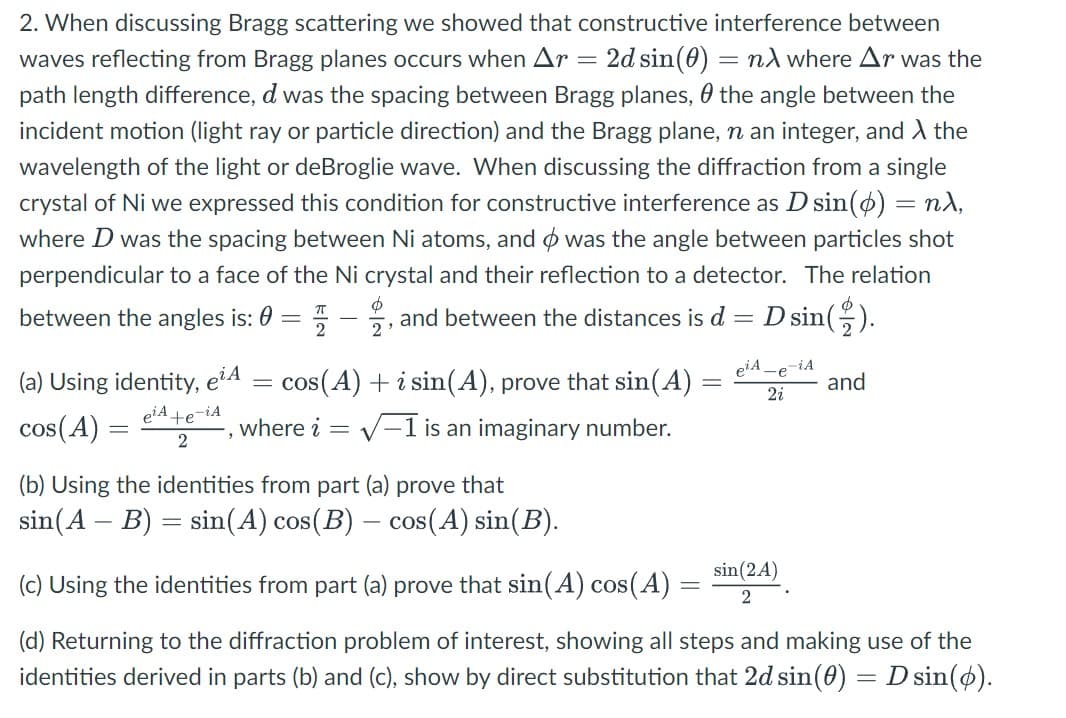2. When discussing Bragg scattering we showed that constructive interference between waves reflecting from Bragg planes occurs when Ar = 2d sin(0) = nλ where Ar was the path length difference, d was the spacing between Bragg planes, the angle between the incident motion (light ray or particle direction) and the Bragg plane, n an integer, and λ the wavelength of the light or deBroglie wave. When discussing the diffraction from a single crystal of Ni we expressed this condition for constructive interference as D sin(ø) = nλ, where D was the spacing between Ni atoms, and was the angle between particles shot perpendicular to a face of the Ni crystal and their reflection to a detector. The relation Φ between the angles is: 0 = and between the distances is d = D sin(). 2 (a) Using identity, e¹A cos(A) e¹A+e-iA 2 cos(A) + i sin(A), prove that sin(A) = where i = √-1 is an imaginary number. = = e¹A-e-iA 2i - (b) Using the identities from part (a) prove that sin (AB) = sin(A) cos(B) – cos(A) sin(B). - (c) Using the identities from part (a) prove that sin(A) cos(A) (d) Returning to the diffraction problem of interest, showing all steps and making use of the identities derived in parts (b) and (c), show by direct substitution that 2d sin(0) = D sin(o). and sin (2A) 2
2. When discussing Bragg scattering we showed that constructive interference between waves reflecting from Bragg planes occurs when Ar = 2d sin(0) = nλ where Ar was the path length difference, d was the spacing between Bragg planes, the angle between the incident motion (light ray or particle direction) and the Bragg plane, n an integer, and λ the wavelength of the light or deBroglie wave. When discussing the diffraction from a single crystal of Ni we expressed this condition for constructive interference as D sin(ø) = nλ, where D was the spacing between Ni atoms, and was the angle between particles shot perpendicular to a face of the Ni crystal and their reflection to a detector. The relation Φ between the angles is: 0 = and between the distances is d = D sin(). 2 (a) Using identity, e¹A cos(A) e¹A+e-iA 2 cos(A) + i sin(A), prove that sin(A) = where i = √-1 is an imaginary number. = = e¹A-e-iA 2i - (b) Using the identities from part (a) prove that sin (AB) = sin(A) cos(B) – cos(A) sin(B). - (c) Using the identities from part (a) prove that sin(A) cos(A) (d) Returning to the diffraction problem of interest, showing all steps and making use of the identities derived in parts (b) and (c), show by direct substitution that 2d sin(0) = D sin(o). and sin (2A) 2
Related questions
Question

Transcribed Image Text:2. When discussing Bragg scattering we showed that constructive interference between
waves reflecting from Bragg planes occurs when Ar = 2d sin(0) = nλ where Ar was the
path length difference, d was the spacing between Bragg planes, the angle between the
incident motion (light ray or particle direction) and the Bragg plane, n an integer, and λ the
wavelength of the light or deBroglie wave. When discussing the diffraction from a single
crystal of Ni we expressed this condition for constructive interference as D sin(ø) = nλ,
where D was the spacing between Ni atoms, and was the angle between particles shot
perpendicular to a face of the Ni crystal and their reflection to a detector. The relation
Φ
between the angles is: 0 =
and between the distances is d = D sin().
2
(a) Using identity, e¹A
cos(A)
e¹A+e-iA
2
cos(A) + i sin(A), prove that sin(A) =
where i = √-1 is an imaginary number.
=
=
e¹A-e-iA
2i
-
(b) Using the identities from part (a) prove that
sin(A - B) = sin(A) cos(B) – cos(A) sin(B).
-
(c) Using the identities from part (a) prove that sin(A) cos(A)
(d) Returning to the diffraction problem of interest, showing all steps and making use of the
identities derived in parts (b) and (c), show by direct substitution that 2d sin(0) = D sin(o).
and
sin (2A)
2
Expert Solution
This question has been solved!
Explore an expertly crafted, step-by-step solution for a thorough understanding of key concepts.
Step by step
Solved in 2 steps with 2 images
